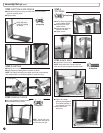Special offers from our partners!

Find Replacement BBQ Parts for 20,308 Models. Repair your BBQ today.

15
Condition The Grill
• Before using the grill for the first time or after storage,
operate grill 15 minutes on high setting, with lid closed, to burn
away oil.
• Once the oil has burned away, check the burner flame per
next step.
The Burner Flame
• Keep the grill lid closed and the cooking surfaces in place.
• Observe the burner’s flame from below the grill bottom.
• Flames should appear similar to the good flame shown in
Fig. 21 and as follows:
• A good flame should be blue with yellow tip.
• Some yellow tips on flames up to 1" in length are acceptable as
long as no carbon or soot deposits appear.
• If flames are excessively yellow and irregular, the oil residue
may not be completely burned off, or the venturi may be
clogged or may not be properly positioned over the orifices.
Allow grill to cool before repositioning venturi over valve and
orifices.
• Grills that have been in use for a while sometimes begin to
show more yellow flame. A build-up of food deposits, fats or
cooking seasonings can cause yellowing flames. Clean the
burner to remove residue and check for clogged burner holes
or blocked venturi (see “Cleaning the Venturi” pg. 16).
• Regular use of your grill will actually help keep it operating
more smoothly.
• Each grill may heat differently. Some units will heat somewhat
more to the center and back of grill. Flavor of grilled food will
improve the more you use the grill and as you become familiar
with it.
Good
Bad
Yellow
Blue
Holes in
Burner
Yellow
Blue
Burner Control Setting Tips
• The high flame setting is too hot for direct cooking. The high
flame setting is good for quick searing of meat, then finish
cooking on medium or low flame settings.
• Use high flame setting with lid
closed to preheat the grill for
5 minutes before cooking and with lid closed for a maximum of
5 minutes after
cooking to burn off grease drippings.
• Use medium flame setting for direct cooking steaks, pork chops,
chicken and hamburgers.
• Use low flame setting for roasts and rotisserie foods.
• Thick steaks will finish with a better texture and more juice if
first seared on high flame setting then cooked on low flame
setting.
Safe Grill Operation
• NEVER leave cooking food unattended. Continually observing
the food will help in maintaining an even temperature, conserve
fuel, improve the food’s flavor and lessen flare-ups.
• To open grill lid, slowly lift handle to avoid burning in case of a
grease fire flare-up.
• DO NOT expose any part of your body directly above the
cooking area.
Food Preparation Hints
Your grill can cook a variety of foods. For best results, follow these
instructions:
• Trim excess fat from meat and poultry. Slash any remaining fat
to stop curling, but take care not to cut the meat.
• Frozen meat and poultry should be thawed prior to cooking.
• Frozen fish and vegetables will cook without thawing.
• Placing frozen food on very hot porcelain cooking grids can
cause temperature shock and crack the finish.
• Salt food after
cooking to help prevent drying out the food.
• Brush naturally lean meats with cooking oil or margarine.
• Cook small pieces of tender foods in foil or on special delicate-
food cooking grids (see Cooking Methods on pg. 16).
• Apply barbecue, tomato or sugar-based sauces no sooner than
the last 10 minutes of cooking.
• Turn food with tongs or spatula; piercing food, especially meat,
tends to dry it out.
Grilling Tips and Hints
21
General Use and Correct Burner Flames
(cont.)
CAUTION
Be certain the gas is shut off at the L.P. cylinder valve anytime
the grill is not in use.
WARNING
• Keep grill area clean and free from combustible materials,
gasoline and other flammable vapors, liquids, and spare
L.P. cylinders.
• DO NOT obstruct the flow of combustion and ventilation air.
• Keep the ventilation opening(s) of the L.P. cylinder enclo-
sure free and clear of debris.
• A barbecue grill becomes hot during use. DO NOT touch
grids, or cooking surfaces.
• Be sure to tighten all hardware (screws, nuts, bolts, etc.)
at least once a year or each grilling season.
1. Turn all burner control knob(s) to off.
2. After burner flame goes out, turn off fuel supply. For an L.P.
cylinder, turn the L.P. cylinder knob in a clockwise direction until
it stops.
General Use and Correct Burner Flames
Shutting Off the Grill
(cont.)
CAUTION
• Before removing spit from grill, make sure gas control
knobs are turned to “OFF.” Use protective gloves or tools
when removing the spit to avoid burn hazard from spit,
food or hot juices.


















